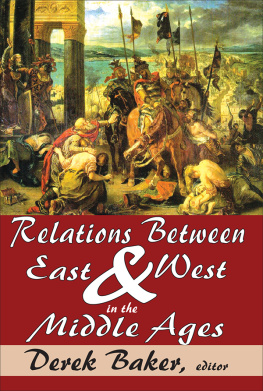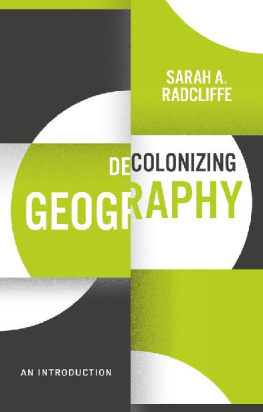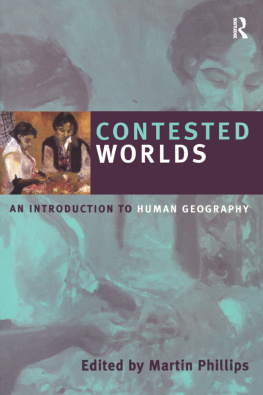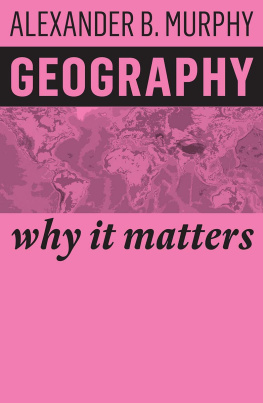ROUTLEDGE LIBRARY EDITIONS: SOCIAL AND CULTURAL GEOGRAPHY
Volume 10
THE CHANGING NATURE OF GEOGRAPHY
THE CHANGING NATURE OF GEOGRAPHY
ROGER MINSHULL
First published in 1970
This edition first published in 2014
by Routledge
2 Park Square, Milton Park, Abingdon, Oxon, OX14 4RN
and by Routledge
711 Third Avenue, New York, NY 10017
Routledge is an imprint of the Taylor & Francis Group, an informa business
1970 and 1972 Roger Minshull
All rights reserved. No part of this book may be reprinted or reproduced or utilised in any form or by any electronic, mechanical, or other means, now known or hereafter invented, including photocopying and recording, or in any information storage or retrieval system, without permission in writing from the publishers.
Trademark notice: Product or corporate names may be trademarks or registered trademarks, and are used only for identification and explanation without intent to infringe.
British Library Cataloguing in Publication Data
A catalogue record for this book is available from the British Library
ISBN: 978-0-415-83447-6 (Set)
eISBN: 978-1-315-84860-0 (Set)
ISBN: 978-0-415-73356-4 (Volume 10)
eISBN: 978-1-315-84826-6 (Volume 10)
Publishers Note
The publisher has gone to great lengths to ensure the quality of this reprint but points out that some imperfections in the original copies may be apparent.
Disclaimer
The publisher has made every effort to trace copyright holders and would welcome correspondence from those they have been unable to trace.
THE CHANGING NATURE OF GEOGRAPHY
Roger Minshull
HUTCHINSON & CO (Publishers) LTD
3 Fitzroy Square, London W1
London Melbourne Sydney Auckland Wellington Johannesburg Cape Town and agencies throughout the world
First published 1970
Reprinted 1972
The paperback edition of this book is sold subject to the condition that it shall not, by way of trade or otherwise, be lent, re-sold, hired out or otherwise circulated without the publishers prior consent in any form of binding or cover other than that in which it is published and without a similar condition including this condition being imposed on the subsequent purchaser
Roger Minshull 1970 and 1972
Printed in Great Britain by litho on smooth wove paper by Anchor Press, and bound by Wm. Brendon, both of Tiptree, Essex
ISBN 0 09 102710 1 (cased)
0 09 102711 x (paper)
CONTENTS
The last sentence of The Spirit and Purpose of Geography, first published in this series in 1951, states that the geographers work subjects him to a discipline and yields him a philosophy. This sentence made such an impression on me that since reading it one of my main preoccupations has been to study the nature of the discipline and to work towards some satisfying philosophy.
In the last twenty years such rapid changes have taken place in the methods and aims of geographers that teachers, students and laymen alike, for whom this series is intended, feel the need for a review of the situation. However, a statement and examination of changes and trends could be very insubstantial for the reader with little grounding in the theory of the nature of geography. This book, therefore, is also intended as an introduction to the nature of geography. A selected bibliography is provided for those who would like to pursue the matter further.
Many geography students really face the question of the nature of their chosen discipline for the first time when they start their special study, dissertation, or whatever it may be called. Their main danger is of ending up with a woolly mixture of geography, history and farming and industrial technology. For this reason I have tried to be as precise as possible about the nature of this discipline which we call geography, sometimes to the point where some geographers would say that the definitions are too exacting and exclusive. But I insist that geography is an exacting discipline and not just a polite name for general knowledge.
In this connection two words have been given precise meanings in this book. The word geographer means a professional earning his living by doing research, and either writing or lecturing about his findings. Teachers and students of geography are referred to as such. The word space, when not qualified, refers to an abstract idea of space, and not to a particular location, and certainly not to the area between the planets.
While some geographers feel a need for geography to be of economic value in planning and development, as a teacher I feel the need for geography to be relevant to much wider issues. The findings of the geographer must be important to any philosophy of the nature and condition of man. The questions posed at the end of this book, then, are concerned not so much with immediate practical problems, as with the need to understand the nature of mans existence in the universe.
As usual I am indebted to Mrs M. M. Tyson for her typing, and to Professor W. G. East for encouraging me to continue writing, and for his generous spirit in accepting this book for the series.
ROGER M. MINSHULL
INTRODUCTION
Many geographers believe that the present rapid change in geography, the quantitative revolution, is resulting in genuine progress. Changes in the past may have been less revolutionary, but it is certainly very difficult to say that progress was made each time. T. W. Freeman goes as far as saying that trends in geography have been like swings of the pendulum and that most of the things we hail as new have been tried or suggested in the past.1
There have been changes in content, approach and techniques. Changes in technique are easily explained as the result of a desire to use the best tools available at any one time, and must occur as technology improves. But changes in content, such as the inclusion or exclusion of human geography, or in approach, such as the swing from study of landscapes to the study of spatial relationships, are much more disturbing. If all three elements of content, method and technique are in constant change, then how can we pretend that a discipline called geography exists?
Recently, in Frontiers of Geographical Teaching, Wrigley2 has suggested that an overall definition of geography is not necessary, partly because it leads to rigidity and stultifies growth. Wrigley may be the spokesman for many other geographers who think this point so obvious that there is no need to write it down. However, the majority of articles on the nature of geography are striving to emphasise guides which will keep geographers on the correct course during this constant change. The main problem is to define the nature of geography in such a way that the definition is neither too narrow so that it applies only to a few specialisms, nor so wide that in practice it is useless.
Superior figures refer to notes at the end of the chapters.
Another problem is the need to formulate a definition which is valuable to the layman, the professional geographer, and to all the students in between. For the interested layman, any short, neat definition here would then need a book of qualification and explanation. Conversely, students can have been studying geography successfully for several years without necessarily comprehending the whole of geography, or being able to give a concise definition. Added to this, we have the increasingly difficult situation of a growing number of specialist professional geographers each defining the subject largely in terms of his own interests.








